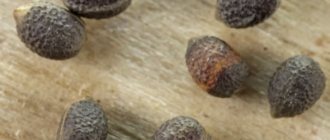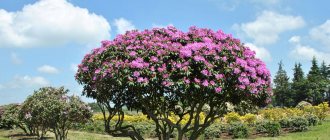When can reproduction be carried out: features
The timing of barberry propagation depends on the chosen method. When cuttings, the procedure is carried out in early spring or, conversely, in the winter. Young branches take root well in greenhouse conditions.
Barberry Thunberg
Dividing the bush is done at the beginning of the season. When the buds begin to swell and the leaves begin to bloom. The leaves will not interfere when dividing the bush. This way you can select the desired piece.
Root shoots appear at the beginning of the season. It takes some of the nutrients from the soil and inhibits the development of the mother bush. It is recommended to remove shoots to make the barberry more luxuriant. But if there is a goal to propagate the plant, then the shoots are left until the end of the season. The procedure begins in the fall.
Propagation of barberry by seeds is a labor-intensive process. The grains are prepared in advance for several months. Layering is done simply. It is advisable at the beginning of the season so that by autumn the new bush can be transplanted to a new location.
It is important to know! The varietal identity is completely transmitted if barberry is propagated by cuttings or shoots.
How to grow barberry from cuttings - cuttings, layering and seeds, in spring, summer and autumn
- cuttings, layering and seeds, spring, summer and autumn
- propagation by cuttings in spring and summer
- How to propagate barberry to create a unique site design, video
- Reproduction of barberry, including in autumn, as well as a description of the main methods
- How and when to propagate barberry from cuttings, video
- Barberry. Propagation by cuttings - Your safe home
- Propagation of barberry by cuttings in the fall at home - Elfterra.ru
Barberry is a fragrant ornamental plant. It is used for various purposes - to improve the garden plot, including cooking. In most cases, the plant grows in the form of a bush, but it can be specifically pruned, resulting in an original tall tree. Various methods are used to propagate barberry, but each of them has its own characteristics and differences. The main thing is to know how to perform proper rooting so that the plant grows quickly.
Peculiarities of barberry propagation in spring, summer and autumn
Barberry is a fairly massive shrub. It has the ability to stretch up to 2 meters. With specific pruning, its structure and shape can be adjusted to the required volume. Its main difference from other trees is its year-round decorative effect due to the fact that it changes the color of the foliage in autumn to a red tone.
Attention! If barberry is not subjected to formative pruning for several years, it will fill the entire area next to it. But if a gardener sets out to independently grow an original plant, with maternal qualities present, then one should be guided by certain methods of propagation
Before you start planting, it is recommended to learn about minor nuances that complicate the reproduction process:
- When planted by cuttings, young shoots produce roots very slowly.
- When dividing the bush into young seedlings, the root system of barberry is revealed to be very delicate. Therefore, during the division procedure, the rhizomes can be easily damaged.
- When planted with seeds, their germination rate is only 40-45%. At the same time, the maternal qualities of the shrub may not appear after the entrance of young seedlings.
- Most varieties do not produce rhizomes when cuttings.
The optimal period for breeding barberry is spring-summer. It is during this period that nutrients are activated in the plant, helping the sprout to acclimatize in a new place and safely release young roots.
When propagating barberry in the fall, it is recommended to plant the plant using seeds immediately in open ground. This way they will undergo natural stratification, which will significantly strengthen future seedlings.
Important! The plant should not be planted in shaded areas of the garden; the shrub loves plenty of sunlight. Does not accept large amounts of water
Lowlands and places with close groundwater are especially not suitable for rooting.
A prerequisite for planting is to lay out drainage at the bottom of a previously prepared hole to bury the young cutting. It is recommended to make it from sawdust, small pebbles and dry fallen leaves.
Root shoots
It is very simple to obtain a seedling from root shoots. But young shrubs do not produce shoots from the root. They should be taken from mature or old plants.
Important! Buds form on the rhizomes, which grow out of the ground as independent shrubs. All young shoots do not go straight from the central part of the barberry, but stretch out next to the bush, on the periphery
If there is such a seedling on the territory belonging to barberry, then it must be dug up according to the following instructions:
- Carefully dig up the bush from all sides.
- Try to dig a hole deeper so that as much of the root system as possible remains from the mother bush for the young cutting.
- It is recommended not to dig up the plant in such a way that the root system is exposed. It is best to transplant a young cutting along with a lump of earth.
- The connection with the mother bush and the cutting should be cut with pruning shears, sprinkling the cut with crushed coal or wood ash.
- Plant the dug up seedling in a new prepared place and cover it with soil.
Propagation by cuttings
It is easier to cut common barberry in summer than in autumn. Thunberg barberry is considered a special variety. It has beautiful flowers and large fruit ovaries. To reproduce, the bush must be no more than 10 years old. After this age, cuttings have difficulty rooting and growing barberry becomes more difficult. How to properly cut barberry?
How to propagate thuja - cuttings and transplantation
It is easy to grow cuttings of ornamental shrubs. The transplant process occurs according to the following algorithm:
- At the beginning of the season, the bush is inspected, young shoots 15-20 cm long are selected. Lignified branches that have 3-4 internodes are also suitable.
- Preparations are made at any time of the year. Planting is carried out mainly in early summer.
- The lower end of the branches is made oblique. This way it will absorb water faster and produce roots.
- If there are leaves, cut them in half.
- On the first day, leave the cuttings in water with the addition of a root formation stimulator.
- Next, the cuttings are transferred to the ground or left in water until the first roots appear.
- If the branches are planted in the ground, they are covered on top with a glass jar or plastic bottle. A greenhouse effect is created inside.
- You can immediately plant the cuttings in a greenhouse.
Additional Information! Without a root formation stimulator, barberry produces roots very slowly.
Cuttings of barberry in summer ensure better survival rate. Winter branches take root worse.
Description of the plant
Barberry is one of the oldest plant families. The main species is the common barberry (Berberis vulgaris) which is very variable. More than 400 species grow naturally in Asia, North and South America, Africa, and Europe.
In our country, the plant is found naturally on slopes, plains, and forest edges, where it creates characteristic dense thickets. Barberries of different types are evergreen and deciduous. The bush is characterized by triple-thorned stipules that actually turn into leaves. Many varieties change the color of their leaves from green to red, purple, and yellow in the fall, decorating the landscape outside the window on cold autumn days.
Barberry can be divided into 2 categories:
- deciduous varieties;
- evergreen varieties.
Typically, gardeners choose deciduous varieties; they are the most common. As a result of interspecific crossings and appropriate selection, the choice of plants is huge:
- varieties with proudly raised branches;
- with lazily hanging shoots;
- low varieties.
You can read more about barberry varieties here -
The small leaves of barberry, like the flowers, are collected in bunches and grow densely on the long shoots of the plant. In May and June, fragrant small yellow or orange flowers appear on the shrubs. All species and varieties have bisexual flowers, 0.5-2 cm in diameter, solitary or collected in clusters. Flowers are self-pollinating, but can also be pollinated by pollen from other species. Pollen is carried by insects, such as bees and bumblebees.
At the end of summer, oblong fruits several millimeters long appear, reaching maturity in the fall. The fruit is spherical or slightly elongated, not very large, red, or black in evergreen species.
Barberry berries are usually red or dark blue in color and have a sour taste.
The berries can hang on the bush until spring, which, unfortunately, is rarely possible - birds adore them.
Deciduous species are quite frost-resistant and suitable for growing in central Russia, these are:
- B. Thunberg (Berberis thunbergii);
- B. common (B. vulgaris);
- B. Korean (B. koreana).
There are many varieties of the plant, differing in leaf color, shape, and growth. Therefore, barberry is readily grown in green areas, parks, and garden plots. The shrub is used to create unformed lines, form hedges (especially in columnar varieties), as a ground cover plant, and, thanks to the varied color of the leaves, as a typically ornamental plant.
Barberry Thunberg is one of the most popular species. Grows well in any garden - undemanding, very decorative. The varieties vary in height; you can find a suitable variety for a small or large garden.
Dividing the bush
Barberry Cobalt - variety description and care
How to properly propagate barberry by dividing the bush? The issue is easily resolved. New bushes quickly take root when:
- They dig up the mother bush.
- They move him to the shade.
- Using scissors, you need to divide the plant into 2 equal halves. At least 3 shoots should come from each daughter barberry.
- 2 holes are dug in the garden. The soil is mixed with fertilizers and well moistened.
- Bushes are planted in a new habitat.
- After 2 weeks, the plants will fully recover.
Barberry in autumn
This method is better for growing young bushes. Digging up a large mature shrub is difficult. During work, you can scratch yourself, break healthy branches and harm the plant.
Air layering
Barberry Ottawa Superba - description and care
How does barberry propagate by layering and what is it? Everything is actually very simple. An adult shrub growing in the garden. Its branches hang straight to the ground. A couple of them remain in the ground. However, it cannot be cut off from the mother plant. The cuttings are kept in this form until the end of the season.
Sections of the branches will receive nutrition from the soil and from the plant at the same time. Therefore, the survival rate is high. Subsequent procedures and care for layering:
- By the end of summer, they check how well the layering has taken root. The roots should be palpable.
- The tops are cut off from the main bush so that at least 3-4 internodes remain in the new plant.
- It is necessary to plant new barberries in their own holes.
- While the shoots are taking root, they are periodically hilled up. The more land at the base, the better the process goes.
- Plantings are watered every week with 500 ml of water. You can’t overwater them so as not to wash away the soil near the trunk.
- Feeding is carried out at the same level with all barberries.
Barberry fruit
You should know! After rooting the cuttings, cut off the top. They leave the new bush next to the mother one to make it easier for it to adapt to the new type of nutrition.
Optimal conditions and timing of planting in open ground
Regardless of the method of propagation of barberry, the best time to plant it is spring. Work can begin as soon as the average daily temperature is +120. At this time, the plant is aimed at intensive growth, so survival will be as fast as possible. But if you plant a seedling with a clod of soil, then this can be done at any time of the year, even in winter, if you prepare fertile soil for backfilling in advance and keep it at above-zero temperatures.
Barberry Thunberg is an extremely unpretentious plant. Grows in various soils in sun and partial shade. Withstands drafts, winds, frosts. In a word - a gardener's dream. But in order to achieve the best decorative effect, you need to create optimal conditions for it, the most important of which is soil. Barberry will adapt to different types of soil, but will reveal itself in all its glory:
- on sandy loam or light loam with a high humus content,
- at pH – 6.5 – 7, slightly acidic or neutral reaction.
When preparing a fertile mixture, combine garden soil, sand, and humus in equal proportions. If the natural soil is poor, then planting barberry requires complete replacement with a fertile mixture in a hole 0.5 x 0.5 x 0.5.
Seeds
How exactly does barberry propagate from red seeds? Similar to other varieties. At the end of the season, several branches with fruits are left until they are fully ripe. By mid-September, seed pods are formed. Collect them and dry them well. Seed germination lasts for 2 years.
Note! Seed propagation is full of surprises. There is no guarantee that the new plant will inherit all the characteristics of the mother shrub.
Seeds are planted in winter or early summer. Seed germination is higher if you plant fresh seeds for the winter. The process is carried out step by step:
- Prepare in advance a bed 20 cm high from nutritious and dry soil.
- Dig holes. Make a distance of 15-20 cm between them, and 30 cm between the rows.
- A day before planting, soak the grains in water with potassium permanganate.
- The next day, place one seed in each hole.
- Seal the holes with overripe humus.
- Cover for the winter with agrofibre or spandbond.
In spring the first shoots will appear. Not all seeds will germinate quickly; some will appear above the ground only at the beginning of summer. When there are 3-4 leaves on the stem, new bushes are planted in a permanent place. The plants are well watered beforehand to ensure root turgor.
When planting seeds in summer, the grains are first stratified. In March, they are laid out in wet rags, covered with cellophane and sent to the top shelf of the refrigerator. Sprout at home on a wet cloth. Sowing is carried out in early May. By the end of the season, sprouts appear. The germination rate of winter sowing is 20% higher than summer sowing. New bushes can stand for some time, and then die if strong shoots grow next to them.
Decorative variety of barberry
How to propagate barberry by shoots?
If you propagate barberry by cuttings, the bushes will grow exactly the same as the mother bushes. When propagated by seeds they will be slightly different.
About the technology, how to cut cuttings and what to do with them later:
- Cuttings are cut from bushes that are no more than 10 years old. These people take root better and faster in a new place. They cut the branches early in the morning, before the dew has evaporated from the grass, trees and bushes. In the shade, many cuttings are taken from the branches. The main thing is that they are protected from direct sunlight, which can dry them out and therefore damage them.
- Take a jar, fill it with water and put bunches of cuttings there. The latter are cut with a budding knife. The owner checks how sharp it is and disinfects the blade.
- The branches are cut obliquely. Each of the cuttings has 2 cuts: the lower one is located behind the bud, and the upper one is located above it. Leaves need to be cut in half. It turns out that each of the processes has 2 or 3 internodes.
- Those branches that are cut and processed are tied tightly in bunches and lowered, for example, into jars of water with the lower edges. In a greenhouse or greenhouse, you need to prepare soil of a certain composition: 1 layer will be leaves that have rotted (this layer will be from 10 to 15 cm) + compost + forest litter + river sand (top layer 4 cm).
- They take a board and compact this soil. Now they water it with water. Some mark seedlings that barberry grows in this area.
- The seedlings need to be placed at an angle and deepened into the sand layer by 0.5 cm. From cutting to cutting you need to retreat 5 cm, from row to row - 7 cm. The cuttings will take root and take root well if the greenhouse is not higher than 40 cm.
- The main thing is to make the greenhouse correctly from the very beginning. Then it will be easy to create high humidity and air temperature in it.
- After planting, the seedlings need to be watered with rain. To do this, use a watering can, or you can use a sprayer. It is good when the water for irrigation is from 20 °C to 25 °C. To keep the humidity high, you need to irrigate the soil 2 or 3 times a day.
- When it is very hot, the greenhouse is ventilated. It's enough to push the boundaries a little. It will take 20 to 25 days and the seedlings will grow roots. Now they can be hardened little by little by opening the greenhouse so that fresh air can flow into them.
- To begin with, 2 hours a day is enough, then every day you need to gradually increase the time for hardening the seedlings. It is best to open the frames after 15:00, when the air is well warmed up.
- The first days of August will come and their glass frames can be removed. Now the cuttings will feel the temperature changes from day to night, they will be washed by dew in the morning, and caressed by the sun during the day.
- Before winter, the seedlings will become much stronger. The plants will overwinter and can be replanted.
Spring transplantation of cuttings
From March 25, and if it’s cold, then by April 5, you need to stretch plastic film over the cuttings, which is usually used by gardeners. Thanks to the film or other suitable material, the soil will warm up faster and the cuttings will come to life.
The humidity in the greenhouse will be higher, which the plant will like, and the transition from daytime to nighttime air temperature will not be so abrupt.
Video about planting, care, and propagation of barberry:
The greenhouse has a beneficial effect on plants and they wake up in it from 14 to 21 days earlier than would happen in the open air. This method is good because experts recommend leaving the seedlings under the film until September.
Don’t forget about regular drip watering with a watering can or sprayer and fertilizing the plants. From June 25, you can begin hardening of seedlings. The film is completely removed from them and then covered. 2 days will pass and the film can be completely removed.
When the plants turn 2 years old, they are ready to be transplanted to a permanent location. This procedure can be done from September 15. If the owner has grown a lot of young barberry bushes, he can plant them around the yard, in the garden, and give them to relatives and neighbors.
Now novice gardeners understand how to propagate barberry from cuttings in spring and summer. The technology is simple and understandable to anyone who grew up in a village or has their own dacha where they worked with bushes and trees.
Root shoots
It is customary to remove the root shoots as they interfere with the normal nutrition of the mother barberry. But if you want to propagate the plant, then shoots are perfect. They inherit all the characteristics of the main bush.
Throughout the season, children are cared for in the same way as adult plants. Closer to September, a place for transfer is being prepared. Fertilize the soil with mineral additives. They dig up the baby and plant it in a new place.
Interesting! If barberry produces new babies, it means it is healthy, full of strength, ready for reproduction and active flowering.
The shoots are true bushes. That’s why their survival rate is high. In the first year, the plant is actively fertilized, watered and covered for the winter. This way it will bloom and bear fruit more quickly. Adding a growth stimulator helps the barberry root.
Common Mistakes
It is not difficult to propagate barberry. However, beginners make mistakes. The most common of them:
- Incorrectly selected cuttings. The length and number of internodes is strictly limited. A branch that is too long will not be able to fully feed, and a short one does not always take root.
- The greenhouse effect has a beneficial effect on survival rate. But it’s worth ventilating the greenhouse once a day. Sprouts need fresh air.
- Too much fertilizer in new soil can burn the roots of the shoot. Add additives strictly according to the instructions.
- It is not recommended to use fresh manure to feed new plants. It contains a large amount of nitrogen, which causes burns.
- Abundant watering is good. But everything should be in moderation. If a lot of moisture accumulates in the ground, the roots and lower part of the cutting will rot.
- When selecting cuttings, they are cut only with a disinfected tool. You can't break off branches. The cut should be oblique, not straight.
- Be sure to use a root former, so new roots will not keep you waiting.
- Cover young bushes for the winter; winter hardiness is not fully evident until the age of three.
Yellow barberry
Thunberg's barberry and its propagation by cuttings are almost no different from other varieties. You need to follow the rules and useful tips and the new shrubs will definitely take root.
Barberry is a wonderful plant that delights gardeners not only with its flowers, but also with its berries. They are used for completely different purposes: they cook compotes, preserves, bake pies and prepare syrups. Shrubs are great for landscape design. They are planted along the fence (it turns out to be a beautiful green hedge).











